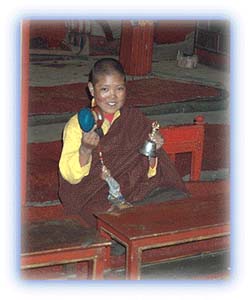Tibet himalayas
General Info
· Trans Himalayas
· Lhasa
· Shigatse
Climate & vegetation
· Rainshadow Effect
People
The Yeti Factor
Photo Features
· Glimpses of Buddhism
· Invaluable Butter
· Agriculture
· Kailash and Mansarovar
· Jokhang Temple

![]()
|
Religion Before Tibet became part of China, Tibetan Buddhism was the religion of the overwhelming majority of the population. Practise of the religion has since been severely restricted. |
 |
|
Young ani (nun) from the Shugseb nunnery. These courageous women have been the object of persecution by the Chinese authorities for their outspoken support of Tibetan freedom and independence. Credit: W. Spiegelman |
Religion is the most important aspect of the life of Tibetans. Tibetan Buddhism is also called Lamaism, a sect of Buddhism that believes strongly in reincarnation and a torturous hell for sinners.
In the 8th century AD the Buddhist scholar Padmasambhava, "born of the lotus," traveled from northern India to Tibet, where he established the first order of lamas, or monks. Thereafter the religion spread rapidly.
Tibetan Buddhist worship consists of reciting prayers and sacred texts and chanting hymns. These are accompanied by trumpets and drums. The lamas perform religious rites. Prayer wheels and prayer flags are important aspects of Lamaism. Charms, talismans, and mystical incantations are also chanted. One of the most frequently repeated incantations is "om mani padme hum" ("o lotus jewel, amen").
 |
| Lamas chanting mantras Credit: Matjaz Vrecko |
Lamaism has many other mystical elements. Lamaism is divided into two sects, the Yellow Hats and the Red Hats. The head of the Yello Hats is the Dalai Lama, who is believed to be the incarnation of God Chenrezi, and when each incarnation dies, his spirit takes on the body of another Tibetan child at birth. Therefore, a baby recognizing objects used by itself in its previous incarnation is chosen as the next Dalai Lama. Another traditional Tibetan custom is giving Hada, a long silk scarf, as token of esteem and good luck.
The religion is organized according to a traditional hierarchy. The supreme position is occupied by two lamas -- the Dalai Lama and the Panchen Lama. The Dalai Lama has a greater influence.
 |
| Lama. Credit: Matjaz Vrecko |
For most Tibetans, the Dalai Lama is the highest being in the world, holy and most revered. Even a photo of the Dalai Lama is considered sacred and of course a great treasure. The Dalai Lama himself lives in exile in Dharamsala, India, together with thousands of Tibetan refugees, protesting against the Chinese invasion of Tibet.
Tibetans do not believe in burying or cremating dead bodies. The remains of the dead are cut up by funeral workers at dawn to feed vultures, in the belief that these birds take the spirits to heaven. Today, Tibet has 50 monasteries open to tourists.
All rights reserved